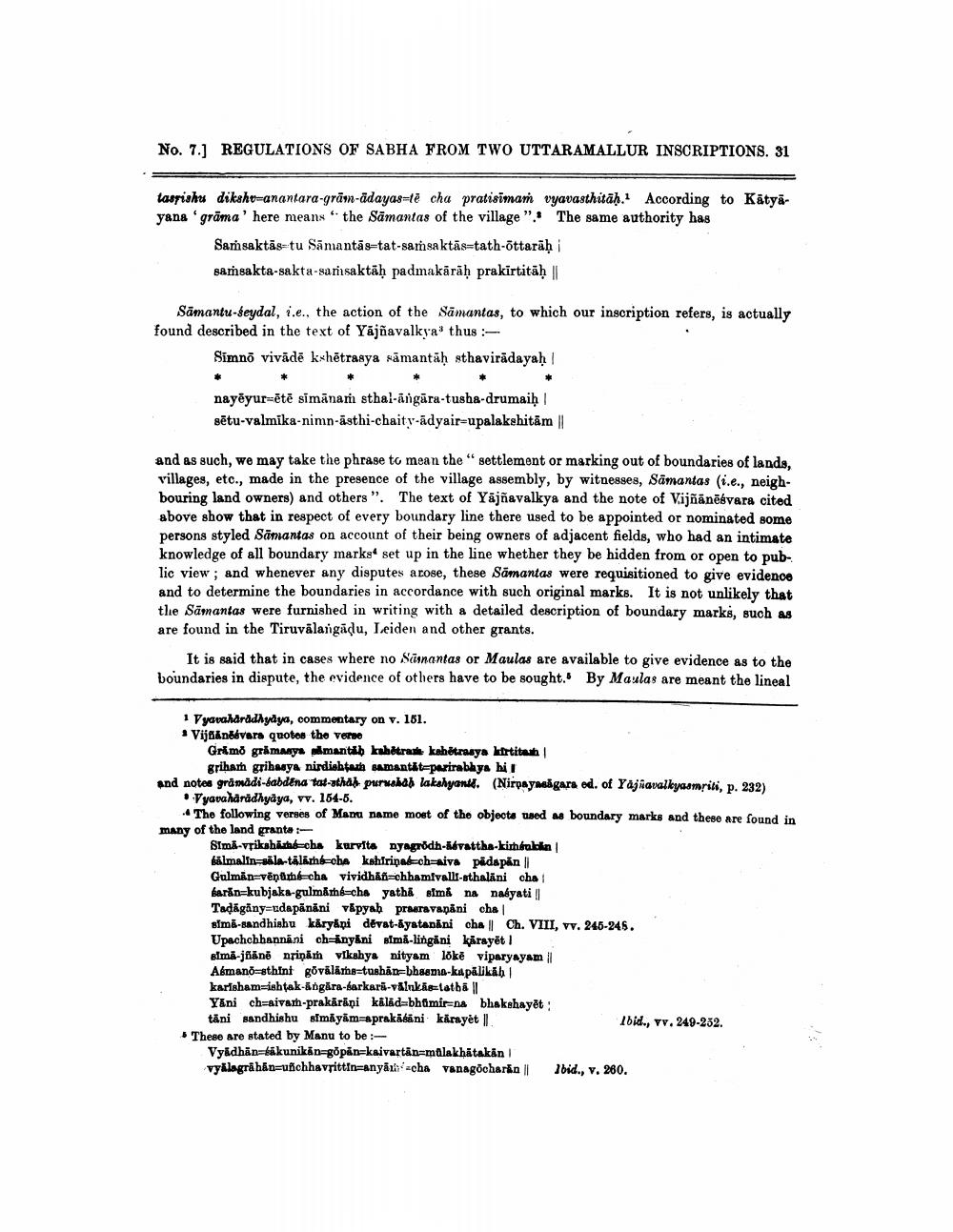________________
No. 7.] REGULATIONS OF SABHA FROM TWO UTTARAMALLUR INSCRIPTIONS. 31
tasrishu dikshv-anantara-gram-adayas-te cha pratisimam vyavasthitaḥ. According to Katyayana 'grāma' here means the Samantas of the village". The same authority has
Samsaktās tu Samantas-tat-samsaktas-tath-öttaraḥ | samsakta-sakta-samsaktaḥ padmakāraḥ prakirtitāḥ ||
Samantu-seydal, i.e., the action of the Samantas, to which our inscription refers, is actually found described in the text of Yajnavalkya3 thus :--
Simno vivādē kshetrasya samantaḥ sthaviradayaḥ |
nayeyur-ētē sīmānam sthal-angāra-tusha-drumaiḥ | sētu-valmika-nimn-asthi-chaity-adyair-upalakshitam ||
and as such, we may take the phrase to mean the "settlement or marking out of boundaries of lands, villages, etc., made in the presence of the village assembly, by witnesses, Samantas (i.e., neighbouring land owners) and others". The text of Yajnavalkya and the note of Vijñānēévara cited above show that in respect of every boundary line there used to be appointed or nominated some persons styled Samantas on account of their being owners of adjacent fields, who had an intimate knowledge of all boundary marks set up in the line whether they be hidden from or open to public view; and whenever any disputes arose, these Samantas were requisitioned to give evidence and to determine the boundaries in accordance with such original marks. It is not unlikely that the Samantas were furnished in writing with a detailed description of boundary marks, such as are found in the Tiruvalangadu, Leiden and other grants.
It is said that in cases where no Samantas or Maulas are available to give evidence as to the boundaries in dispute, the evidence of others have to be sought. By Maulas are meant the lineal
1 Vyavahärädhyaya, commentary on v. 151. Vijääneévers quotes the verse
Grāmō grāmasya samantab kahetras kahetrasya kirtitah
griham grihasya nirdishtah samantat-parirabaya hi
and notes gråmadi-babdena tat-thab purushab lakshyante. (Nirpayasagara ed. of Yajnavalkyasmṛiti, p. 232)
• Vyavaharadhyaya, vv. 154-5.
4 The following verses of Manu name most of the objects used as boundary marks and these are found in many of the land grants :
Sima-vrikshahé cha kurvita nyagrödh-äévattha-kirhénkin | éälmalin-sala-tälämhé-cha kahiripa-ch-aiva pädapan || Gulman vēnāmé cha vividhäñ-chhamivalli-sthalani cha saran-kubjaka-gulmämhé-cha yatha sima na naéyati || Tadagany=udapānāni väpyaḥ praaravanani cha |
sima-sandhishu käryäni dévat-ayatanani cha | Ch. VIII, vv. 245-245. Upachchhannani ch-anyäni simä-lingāni kärayēt
sima-jñānē nriņām vikshya nityam lõke viparyayam || Aémano-sthini gövälärns-tushän-bhasma-kapälikäḥ |
karisham-ishtak-āngāra-sarkarā-välnkās tatha ||
Yani ch-aivamh-prakäräpi käläd-bhüimir-na bhakehayet: täni sandhishu simāyām-aprakāśāni kärayet || These are stated by Manu to be:
Vyädhäntäkunikān-gōpan-kaivartan-malakḥātakan | vyälagrähän=ufichhavrittin-anya cha vanagōcharan ||
Ibid., vv. 249-232.
Ibid., v. 260.




